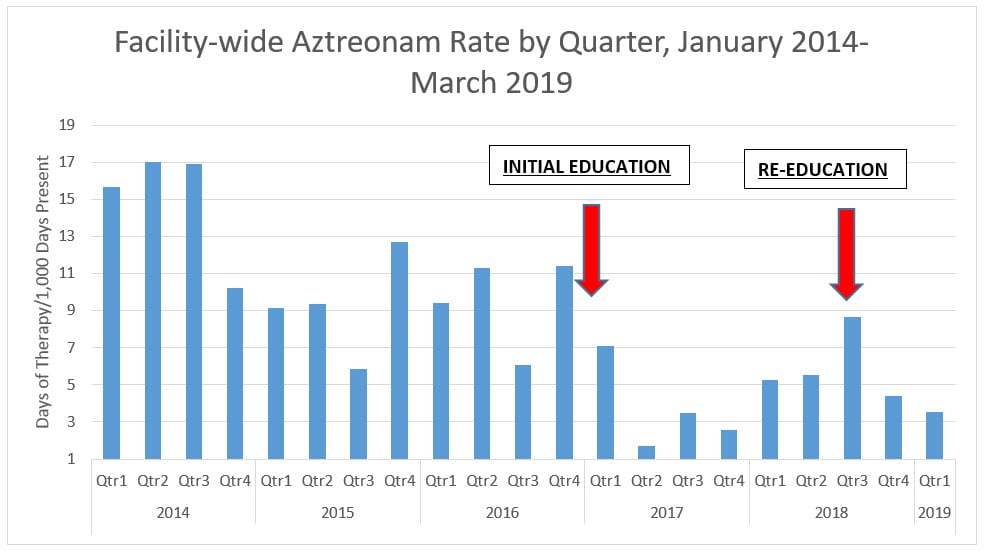Decreasing Aztreonam Use in a Veterans Affairs Hospital
Key Take Away Points
- A Veterans Affairs (VA) hospital evaluated use of aztreonam by analyzing NHSN Antimicrobial Use (AU) Option data pulled monthly from NHSN.
- The Pharmacy and Therapeutics (P&T) Antimicrobial Subcommittee determined that use of aztreonam was higher than anticipated. Training and educational materials were provided to evaluate risk of adverse reaction from beta-lactam administration in a patient whose recorded medical history included a penicillin allergy and recommended alternative agents based on this risk.
- Ongoing tracking using NHSN AU data has allowed the facility to assess the intervention and provide further education as needed.
Jesse Brown VA Medical Center is a tertiary care facility classified as a Clinical Referral Level II Facility located in Chicago, Illinois. It is a teaching hospital, providing a full range of patient care services, with state-of-the-art technology as well as education and research. The Antimicrobial Stewardship Program consists on an Infectious Diseases (ID) trained pharmacist with support from an ID physician.
The Need
The facility began submitting AU data to NHSN in January 2013. NHSN AU data are reported on a bi-monthly basis to the P&T Antimicrobial Subcommittee where data are discussed and decisions are made to improve antimicrobial prescribing. Initially, efforts focused on evaluating use of broad-spectrum antimicrobials with the highest use (piperacillin/tazobactam and vancomycin). After several medication use evaluations (MUEs) to evaluate both agents, the focus shifted to a review of prescribing patterns of other anti-pseudomonal agents. In late 2016, the P&T Antimicrobial Subcommittee identified aztreonam as an area where inappropriate prescribing was likely high throughout the facility given that this antimicrobial has less than optimal susceptibility to Pseudomonas aeruginosa on the facility’s antibiogram.
The Intervention
The P&T Antimicrobial Subcommittee made the decision to provide the inpatient pharmacists with education and an educational tool to evaluate the risk of an adverse reaction, in conjunction with the prescriber, from beta-lactam administration in a patient labeled with a penicillin allergy. The educational tool also provided guidance for recommending alternatives to aztreonam based on this risk. The facility decided to focus on providing education to the inpatient pharmacists given that new medical students and residents rotate through the facility monthly; therefore, it is difficult to provide long-term monthly education to all prescribing physicians.
The Result
After providing education to the inpatient pharmacists in January 2017, prescribing of aztreonam decreased substantially (Figure). Also since January 2017, the facility has used the NHSN AU Option data to look for spikes in aztreonam use and provided re-education to the inpatient pharmacists in July 2018 due to an uptake in use. As of the 1st Quarter of 2019, the use of aztreonam at the facility has decreased to approximately 10 antimicrobial days per 1000 days present.
The P&T Antimicrobial Subcommittee continues to regularly evaluate the NHSN AU data and discuss antimicrobial prescribing trends. The site plans to continue annual re-education with a competency test to ensure all inpatient pharmacists have the tools needed to continue to make these interventions to decrease inappropriate prescribing of aztreonam.

For more information contact: Lisa R. Young, PharmD, BCIDP
Infectious Disease Pharmacist, Pharmacy Service
Jesse Brown Veteran Affairs Medical Center
Lisa.Young2@va.gov
Note: The findings and conclusions in this report are those of the authors and do not necessarily represent the official position of the Centers for Disease Control and Prevention or Department of Veterans Affairs.